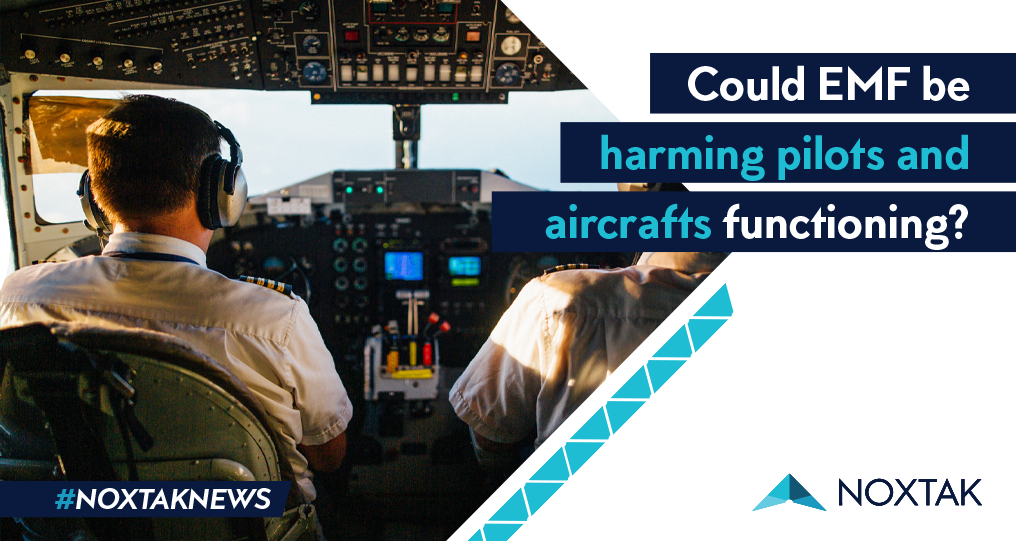CEO’s Office

Abstract:
An aircraft is constantly generating electromagnetic fields due to its electrical, communications, and positioning systems. Flight crews, especially pilots, are exposed to elevated levels of these magnetic fields and cosmic radiation. Having this in mind, DARPA (U.S. Defense Advanced Research Projects Agency) started a two-year project to investigate whether the pilots are being harmed and up to which point.
Key questions:
Are pilots being harmed by the electromagnetic field accumulated in the cockpit? Could this damage lead to accidents or crashes? Is this also affecting the aircraft? How is this applicable to commercial flights and crews? Is there a way to protect them from these emissions and avoid further problems?
Officials of the U.S. Defense Advanced Research Projects Agency (DARPA) are warning that pilots’ ability to think may be harmed by the radiofrequency and electromagnetic fields emitted from the electronics in their aircraft. The problem could be making pilots so disoriented that they crash their planes, fears DARPA, the Pentagon’s pet research agency stated for Forbes.
“Current cockpits are flooded with radio frequency (RF) noise from on-board emissions, communication links, and navigation electronics, including strong electromagnetic (EM) fields from audio headsets and helmet tracking technologies,” warns a new DARPA research project. “Pilots often report minor cognitive performance challenges during flight, and from 1993 to 2013, spatial disorientation in US Air Force pilots accounted for 72 Class A mishaps, 101 deaths, and 65 aircraft lost.”
Some background investigations on this subject
Back in 2001, Gary C. Butler and Joyce S. Nicholas published an article called Magnetic Fields on the Flight Deck, oriented to airline pilots. In this article, they opened by saying that airline pilots operate within an environment that exposes them to magnetic fields, as well as cosmic radiation, sound, vibration, reduced atmospheric pressure, mild hypoxia, low humidity, and circadian dysrhythmia. “These occupational exposures may physiologically challenge the long-term health of airline pilots. Given the complexity of the environment and the possibility of synergistic effects, learning the amount of each exposure is necessary for evaluating any potential health risk”.
In 1998, they carried out an investigation especially focused on magnetic fields in several airplane types. They found that magnetic field strength varies with stages of flight, location within the airplane, and type of airplane. In general, the magnetic field strength at passenger positions tends to increase as one approaches the front of the airplane, suggesting that exposures to pilots on the flight deck might be higher than exposures to passengers.
Then, in November of 2002, the Epidemiology journal published the article Cohort Mortality Study of German Cockpit Crew, made between 1960 and 1997. In this article, Hajo Zeeb, Maria Blettner, Gaël P. Hammer, and Ingo Langner, stated that the crew in civil aviation are exposed to several potential health hazards, among them cosmic ionizing radiation.
The goal of this cohort study among the cockpit crew was to assess the influence of occupational and other factors on mortality. To achieve this, all pilots and other cockpit personnel of two German airlines were traced through registries and other sources for the period 1960-1997. They calculated the standardized mortality ratios, with German population rates as the reference; estimated the individual radiation dose based on individual job histories, and assessed dose-response trends in stratified and regression analyses.
“We compiled a cohort of 6061 male cockpit personnel, yielding 105,037 person-years of observation. The maximum estimated individual radiation dose was 80.5 mSv. Among 255 deaths overall, there were 76 cancer deaths… A slight increase was seen in brain cancer. Employment duration was associated with the all-cancer mortality in Poisson regression analyses”, the investigators stated.
DARPA’s investigation
DARPA’s Impact of Cockpit Electro-Magnetics on Aircrew Neurology (ICEMAN) is a two-year project that aims to determine whether radio waves and magnetic fields are harming pilots. This is based on previous DARPA researches that found that “human brains sense magnetic fields, like those used by animals for navigation, and that this process is ‘jammed’ (i.e., disrupted) by radio waves (RF), impacting brainwaves and behavior. Furthermore, recent findings were the first to show that even weak RF fields and ‘earth strength’ magnetic fields have measurable, reproducible effects on human brainwaves and unconscious behavior in a controlled environment.”
Phase I of ICEMAN will determine how much radio frequency and electromagnetic field noise are present in cockpits. Phase II will examine the effects of RF and EM noise on the human body. Researchers will be asked to design sensors to measure these effects and to find ways to mitigate them.
According to Forbes, the U.S. military fears that some crashes may have been caused by electromagnetic fields. But currently, there is no way to be sure about this suspect. “It has been hypothesized that the cockpit RF and EM fields may influence cognitive performance including task saturation, misprioritization, complacency, and Spatial Disorientation,” DARPA notes. “However, EM fields and radio waves in cockpits are not currently monitored, little effort has been made to shield pilots from these fields, and the potential impacts of these fields on cognition have not been assessed.”
With time, cockpit electronics have become more powerful than we can imagine. As an example of this, DARPA notes that current tactical audio headsets project magnetic fields up to 10 times earth strength. And the high-powered radars are not the biggest concern now, as DARPA affirms that pilots of cutting-edge aircraft, such as the F-35 stealth fighter, are encased in an electronic cocoon of powerful sensors, audiovisual displays, and special high-tech helmets.
DARPA stated that this problem affects commercial as well as military pilots. “If this research and development effort reveals negative impacts of cockpit EM/RF environments on human cognitive function or physiological sensor performance, it is expected to generate interest from the commercial airline industry as well as other industries in which humans are exposed to similar EM/RF conditions.”
Could the aircraft be affected too?
We know artificial EMF can also affect the functionality of electronic devices, such as the ones used by pilots for orientation and communication purposes. That’s part of the answer to why you are not allowed to use your cellphone while flying.
The planes nowadays are well-shielded to avoid any further interference due to devices working inside them, they are designed to work depending on all the heavy-duty technologies and electronics needed. You might even find some airplanes with Wi-Fi now. Though It is uncertain if the lifecycle of many of those devices could be longer if these electromagnetic fields get to decrease at some point.
But even if the planes are designed for this, the human body is not, and that’s the increasing concern not only for military pilots but also for commercial pilots, crews, and constant passengers.
My conclusions
According to my personal experience, I met several pilots with certain levels of EHS (Electrohypersensitivity), but they just got used to living with regular headaches (solved with a common aspirin), and certain levels of irritability, stress, and fatigue; so they usually have the habit of consuming more energy drinks, from coffee to stronger compounds. So, what we need to understand are the typical common symptoms they experience and study them so we can relate them later with the real affection they might be facing.
In science, the change of variables is key to finding answers and avoiding wrong conclusions. If we don’t include the variable of artificial EMF, we are not taking into account all the aspects affecting pilots and crew members. We need to be aware of all the changes in variables. Otherwise, we will miss the big picture and we would possibly never understand what’s happening.
We already know the common symptoms caused by artificial EMF, the biological effects, and long-term health risks. My concern now is not the exposure from outside the plane or the transmission of radio frequencies (RF) between the plane and the closest airports. In this case, the variable that is changing continuously is the near field exposure from microwave radiation. All the passengers and crew are using cellphones with active Bluetooth and WiFi connections (microwave radiation), and frequently some passengers reject the suggestion to put the cellphone in airplane mode, so they leave it active, which increase the emissions from the cellphones with low-frequency fields as they try to connect to a non-existing cell phone tower nearby. So, can you imagine the amount of near field exposure inside a plane nowadays?
Now, we can connect to a WIFI hotspot in most commercial flights, so the plane is exponentially saturated with a huge amount of microwave radiation. I’m not saying this will harm the plane functioning, because the manufacturer prevents this from happening with very isolated protocols to sensitive electronic devices and computers inside the plane, and with the Electromagnetic Compatibility (EMC) test, of course.
But a very subtle emission of microwave radiation from WiFi is potentially harmful to us because our cells are much more sensitive and vulnerable than technology. Have in mind that even when the EMC test says it’s a “safe” emission, it means safe for other nearby technologies or free of excessive Electromagnetic Interference (EMI). However, the electrosmog that is harming us is subtle, is made of electromagnetic disturbances that spread with WiFi/Bluetooth; and inside a plane, which is basically a metallic box, these artificial polarized microwaves behave with more unbalances and disturbances.
Crew members are continuously exposed to this, and that’s only in commercial flights. But F-35 Air Force pilots like the ones mentioned above, are fully immersed in this type of industrial electrosmog with the military standard requiring more technology, which is harming these pilot’s long-term health. And probably in the very short-term too, reducing their capability to fly calmed and fully focused.
What I mentioned before about astronauts in space, also applies to most air force pilots because of the modernization of the aircraft. But we can’t forget commercial flights, in which crew members are getting more and more exposed than ever before.
Like I said so many times in the past: electrosmog control should not be a luxury, it definitely is a necessity in today’s world. We have to raise awareness that electrosmog is an environmental toxin that harms our bodies, the environment, and natural ecosystems; so it’s time every industry starts to take it seriously at the moment of creating new technologies, trying new practices, and especially when exposing humans to it.

Joaquín Machado
CEO NOXTAK. EMF specialist and researcher. Advisor on green technologies, IoT, and smart cities.
